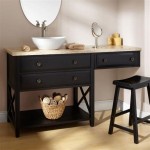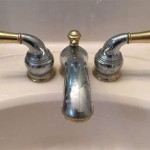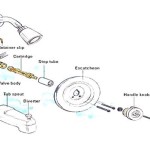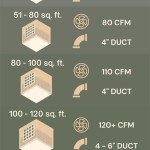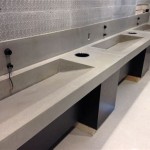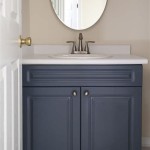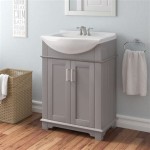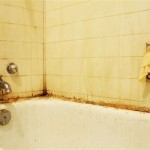Bathroom Single Sink Vanities: A Comprehensive Guide
Single sink vanities remain a popular choice for bathrooms due to their versatility, space-saving design, and affordability. They offer a practical solution for smaller bathrooms, powder rooms, or guest bathrooms where space is at a premium. This guide explores various aspects of single sink vanities to aid consumers in making informed purchasing decisions.
Key Considerations When Choosing a Single Sink Vanity
Selecting the right single sink vanity involves evaluating several factors to ensure it meets both functional requirements and aesthetic preferences.
- Size and Dimensions: Accurate measurements of the available bathroom space are crucial. The vanity's depth, width, and height must complement the room's proportions without obstructing doorways or other fixtures.
- Storage Capacity: Consider storage needs. Vanities with drawers, shelves, or cabinets provide organized storage for toiletries and other bathroom essentials.
- Style and Design: Single sink vanities come in a vast array of styles, from traditional to modern, to match any bathroom décor. Factors to consider include the vanity's shape, color, and hardware.
- Material and Durability: The vanity's material impacts its durability, water resistance, and maintenance requirements. Common materials include solid wood, engineered wood, MDF, and PVC.
- Budget: Single sink vanities range in price from budget-friendly to high-end, depending on the material, features, and brand.
Exploring Different Vanity Styles
Understanding the nuances of various vanity styles helps homeowners achieve a cohesive bathroom design.
- Traditional Vanities: Characterized by ornate details, decorative carvings, and rich wood finishes, traditional vanities offer a classic and timeless appeal.
- Modern Vanities: Clean lines, minimalist designs, and sleek materials like glass or metal define modern vanities. They often feature integrated sinks and minimalistic hardware.
- Transitional Vanities: Blending elements of both traditional and modern styles, transitional vanities offer a versatile aesthetic that suits a wide range of bathroom designs.
- Rustic Vanities: Emphasizing natural materials and textures, rustic vanities often incorporate reclaimed wood, stone, or metal accents for a warm and inviting feel.
Vanity Materials: Pros and Cons
Each vanity material presents unique advantages and disadvantages regarding durability, maintenance, and cost.
- Solid Wood: Offers superior durability and a timeless aesthetic but requires regular maintenance and can be more expensive.
- Engineered Wood: A cost-effective alternative to solid wood, offering good durability and moisture resistance.
- MDF (Medium-Density Fiberboard): An affordable and versatile material, but less resistant to moisture damage compared to solid wood or engineered wood.
- PVC (Polyvinyl Chloride): Highly water-resistant and easy to clean, making it a suitable choice for humid bathroom environments.
Installation Considerations for Single Sink Vanities
Proper installation ensures the vanity's functionality and longevity.
- Plumbing Requirements: Verify the vanity's plumbing configuration aligns with the existing bathroom plumbing.
- Wall Mounting vs. Free-Standing: Consider whether the vanity will be wall-mounted or free-standing, impacting installation requirements and stability.
- Professional Installation vs. DIY: While some homeowners opt for DIY installation, professional installation ensures correct plumbing connections and secure mounting.
Maximizing Storage in a Single Sink Vanity
Clever storage solutions optimize the functionality of a single sink vanity, even in smaller bathrooms.
- Drawers with Organizers: Drawer organizers maximize storage efficiency by compartmentalizing items.
- Pull-Out Shelves: Provide easy access to stored items within the vanity.
- Vertical Storage: Utilizing vertical space within the vanity maximizes storage potential.
Maintenance and Care Tips
Proper maintenance prolongs the lifespan of the vanity and preserves its appearance.
- Regular Cleaning: Wipe down the vanity regularly with a mild cleaner appropriate for the material.
- Avoid Harsh Chemicals: Harsh chemicals can damage the finish and shorten the vanity's lifespan.
- Address Leaks Promptly: Promptly addressing leaks prevents water damage to the vanity and surrounding areas.
Accessorizing Your Single Sink Vanity
Thoughtful accessories enhance both the functionality and aesthetics of the vanity.
- Mirrors: A well-chosen mirror complements the vanity's style and enhances the bathroom's lighting.
- Lighting Fixtures: Proper lighting improves visibility and creates a welcoming atmosphere.
- Hardware: Updating the hardware can refresh the vanity's appearance and match the bathroom's décor.
By carefully considering these factors, homeowners can select a single sink vanity that meets their functional needs, aesthetic preferences, and budget, ultimately enhancing the overall bathroom experience.

New This Week 5 Stylish Single Sink Bathroom Vanity Areas

25 Single Sink Bathroom Vanity Design Ideas

Custom Single Sink Vanity Handmade Lifetime Warranty

Custom Vanity Bathroom Cabinetry Design Line Kitchens

16 Single Sink 48 Inch Bathroom Vanities Kelley Nan

36 Malibu Single Bathroom Vanity Honey Alder Vanities Depot

Ready For Stain Custom Single Sink Vanity Handmade

Sausalito 26 Single Sink Vanity Pottery Barn

Allen Roth Brookview 36 In Slate Blue Undermount Single Sink Bathroom Vanity With Carrara Engineered Marble Top At Com

Bathroom Vanity One Sink Allows More Counter Space Coun Style Custom
Related Posts
